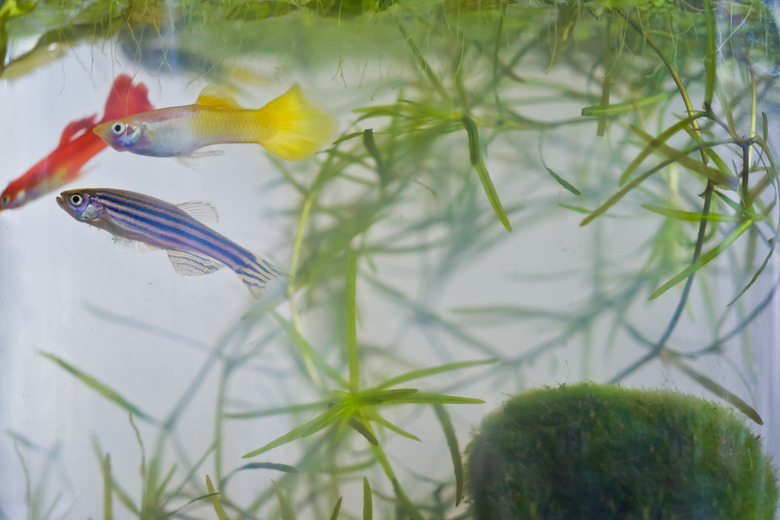How To Make A Self Contained Ecosystem For The Classroom
We may receive a commission on purchases made from links.
The easiest way to learn about the inner workings of an ecosystem is by getting your hands a little dirty. As you build your own ecosystem model from scratch, you will see firsthand what it takes to put the pieces of a working ecosystem together. This is a great science project for students curious about how living things are connected with one another. Are you excited? Great, let's get started!
What Is a Self-Sustaining Ecosystem?
What Is a Self-Sustaining Ecosystem?
Think of a pond in the forest. In a way, it is its own ecosystem – it has plants, animals and microbes all living together in one place. Most importantly, though, the pond is an ecosystem because everything in it works together.
In the pond ecosystem, the sun shines light on the plants, which in turn use that light to grow and fill the water with oxygen. Fish and snails munch on the tasty plants and exhale carbon dioxide while excreting the nutrients they find in the plants. Hidden in the soil below are huge communities of microbes that are invisible to the human eye. These microbes are important to the system because they break down the stuff left behind by the fish and other animals, fertilizing the water in the pond with plant food.
Everything in the pond is used and recycled, allowing the whole ecosystem to keep going as long as the plants can get enough sunlight. Remember that this is the key to making a self-sustaining ecosystem – there has to be a food chain with plants, animals and microbes all making up the links.
Time to Make Your Own!
Time to Make Your Own!
Now that you know what a self-sustaining ecosystem is, let's build one. First you're going to need a few supplies.
Things Needed
- A large, clear glass container with a lid (a reused one gallon pickle jar will do)
- Potting soil
- Sand
- Water
- Aquatic plants
- Aquatic Snails
- Goldfish
Let's Get Building!
1. Create Soil and Sand Layers.
Fill the clear glass container with potting soil to a depth of about two inches. The container will be the enclosure for the ecosystem, and it is important that it is clear to let in the maximum amount of light. Add a layer of sand on top of the potting soil, also to a depth of about two inches. You should now have two layers in your container: two inches of soil and two inches of sand.
2. Add Water.
After creating your soil and sand layers, it's time to add water to your ecosystem. Carefully fill your container with pond water, making sure not to disturb the sand layer.
Using pond water means you now have a key component of your ecosystem in place. That pond water is teeming with microbes and algae that will keep your ecosystem alive and healthy by decomposing waste and recycling nutrients.
3. Introduce Plant Life.
After filling your pond with water, it's time to start planting. Gently transplant some aquatic plants into your ecosystem. You can find these plants at any aquarium store, and anything that can be fully submerged in water should work. You can use your finger or a long wire to carefully press the roots of the plants into the sand. At this point, wait for a day or two to make sure the plants are taking root appropriately before moving onto the next step. You will be adding animals next, and it is important to make sure the plants are thriving first.
What your ecosystem should look like is a layer of soil in the base with a layer of sand on top. The remainder of the jar should be filled with water that fully covers the sand. The depth of the water will vary depending on the size of the container you are using, but the water should almost reach the top, completely submerging the plants.
4. Add Your Snails and Fish.
In order to be self-sustaining, you need to add something to your ecosystem to eat the plants, and freshwater aquatic snails from your local aquarium store fit the bill perfectly. Using a spoon, carefully lower your snails into the water and place them onto the sand.
The last thing we will add is the fish. For this, you should use goldfish from your local aquarium store. Depending on the size of your container (and also the fish), you may only need two or three. One at a time, pour the fish into the ecosystem. It is better to have too few than too many, so make sure not to overcrowd them.
5. Close Your Ecosystem.
Finally, loosely place the lid on top of your container, being careful not to completely seal it, and place your self-sustaining ecosystem near a light source. Make sure the light source doesn't heat the water. There you have it! You have built a small enclosure that resembles your own freshwater pond.
Cite This Article
MLA
Brennan, John. "How To Make A Self Contained Ecosystem For The Classroom" sciencing.com, https://www.sciencing.com/make-self-contained-ecosystem-classroom-7634975/. 30 September 2021.
APA
Brennan, John. (2021, September 30). How To Make A Self Contained Ecosystem For The Classroom. sciencing.com. Retrieved from https://www.sciencing.com/make-self-contained-ecosystem-classroom-7634975/
Chicago
Brennan, John. How To Make A Self Contained Ecosystem For The Classroom last modified August 30, 2022. https://www.sciencing.com/make-self-contained-ecosystem-classroom-7634975/
